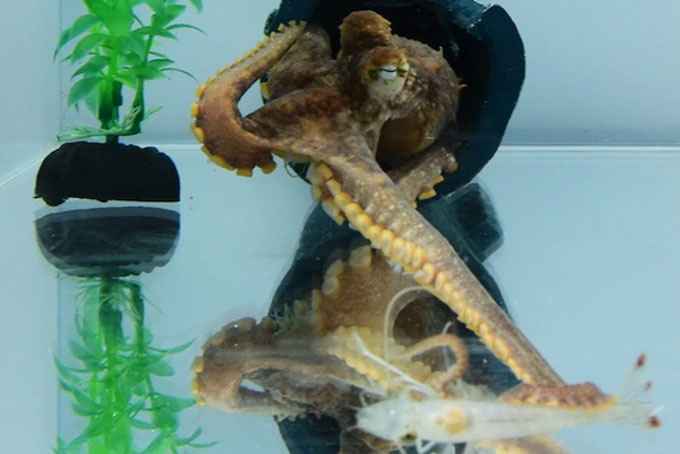New research shows that octopuses can control their choice of a preferred arm specifically for catching a certain type of prey.

A moment of the octopus attacking its prey. (Photo: University of Minnesota).
In experiments with the California two-spot octopus, researchers examined the reactions of this invertebrate when crabs and shrimp were introduced into their tank. The octopuses concealed themselves in their dens, peeking out with one eye.
Hundreds of clips revealed that they consistently used their second arm from the center, the side with their observing eye, to catch prey. They only resorted to other arms when necessary to assist.
Researchers noted that although all eight arms share the same anatomical structure and are considered similar, the use of a specific arm for a particular action reflects a unique evolutionary adaptation.
Crabs and shrimp have different movement patterns and speeds, requiring octopuses to employ various attack strategies. For instance, the second arm moves like a cat pouncing to catch crabs, as crabs crawl much slower than jumping shrimp.
Octopuses use their preferred arms to hunt
For the more agile shrimp, octopuses initiate their hunt with the second arm but at a slower pace, then combine intricate movements to deceive the prey.
Octopuses are known for their mimicry during foraging, and they sway their arms near the shrimp to familiarize themselves with the movements of the shrimp’s antennae and sensory hairs, thereby reducing the shrimp’s chances of escaping. Once that arm has blocked the shrimp, the adjacent arms (1 and 3) assist in securing the shrimp.
It appears that the habit of using the second arm to attack shrimp is related to the octopus’s vision. Each eye of the octopus has very limited movement but covers 180 degrees with a virtual overlap of zero, combined with a stationary head, suggesting that octopuses prefer to target prey in the center rather than at the edges.
By simplifying the hunting process through the use of the second arm with assistance from other arms when needed, octopuses can maximize their chances of obtaining food from their environment.
Moving forward, biologists will analyze how the neural mechanisms operate in relation to these precise movements. They do not believe that the octopus’s central nervous system necessarily controls the other arms for hunting; rather, it is more of a reflex action.
According to them, a better understanding of the mechanical functions behind the coordination of octopus arms could be beneficial in developing soft robotics, particularly robots that operate underwater.
Biologist and study author, Professor Trevor Wardill at the University of Minnesota, USA, stated: “If we understand the movement mechanisms of octopuses, we can apply that knowledge to create underwater vehicles or soft robotics applications.”


















































